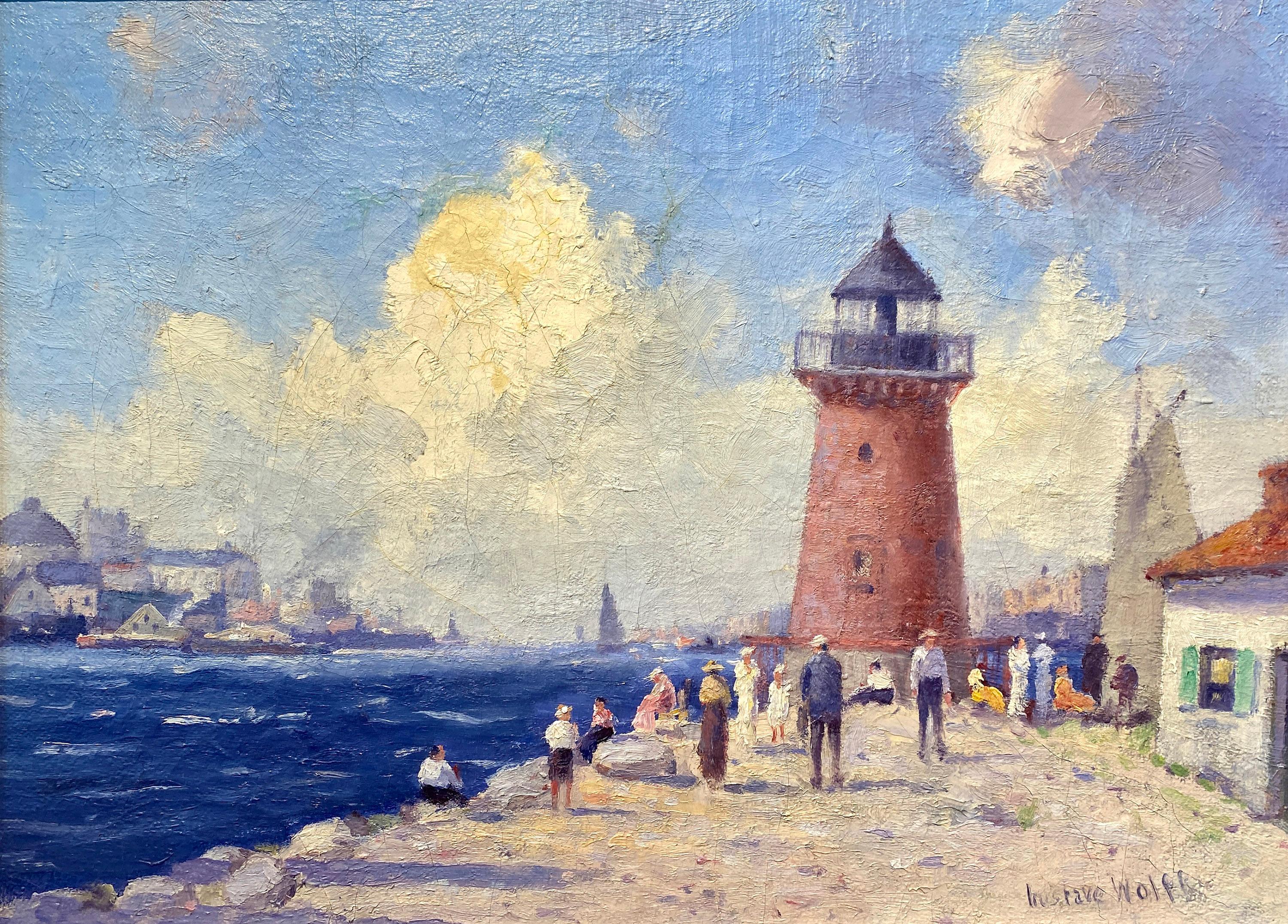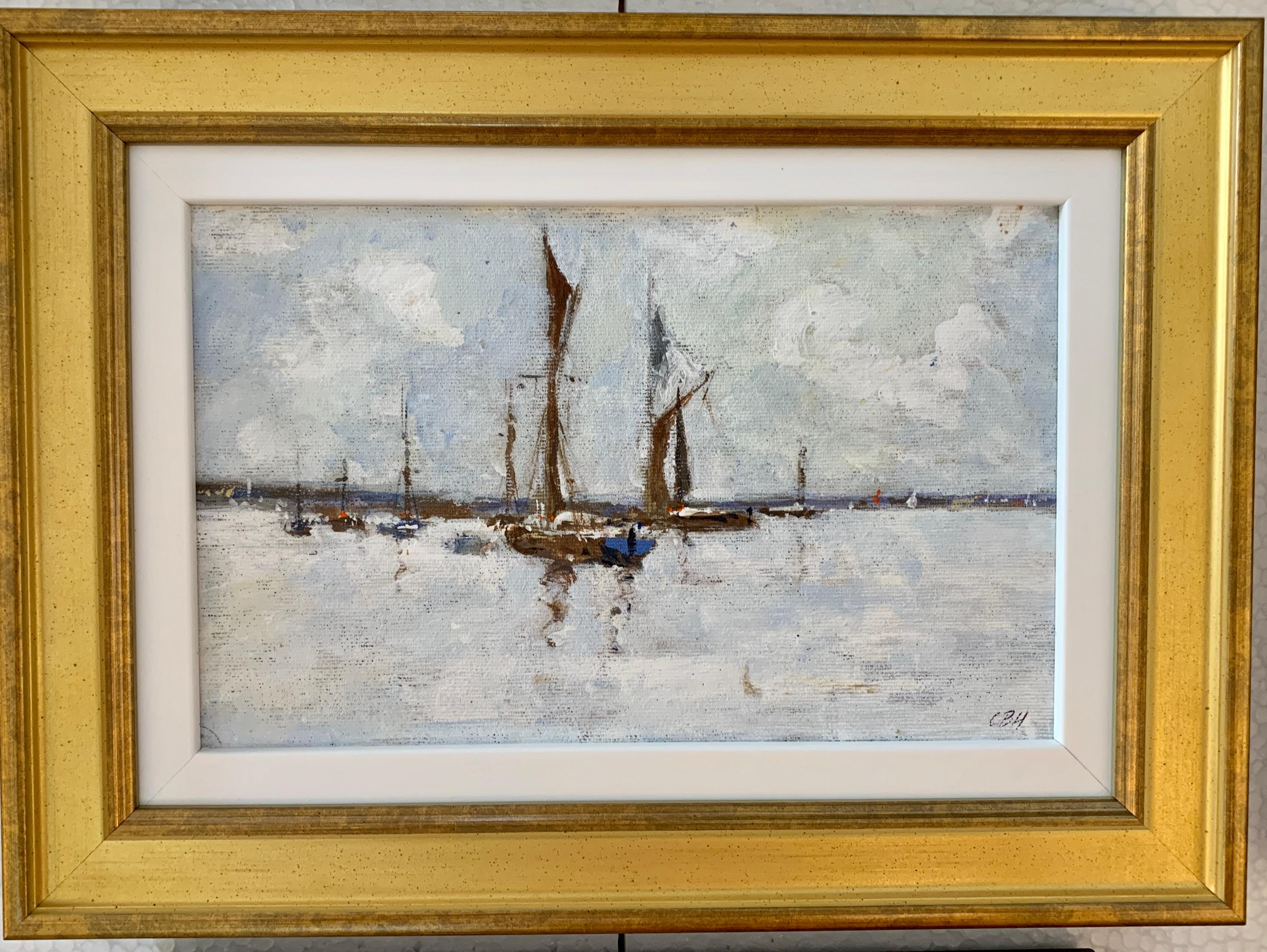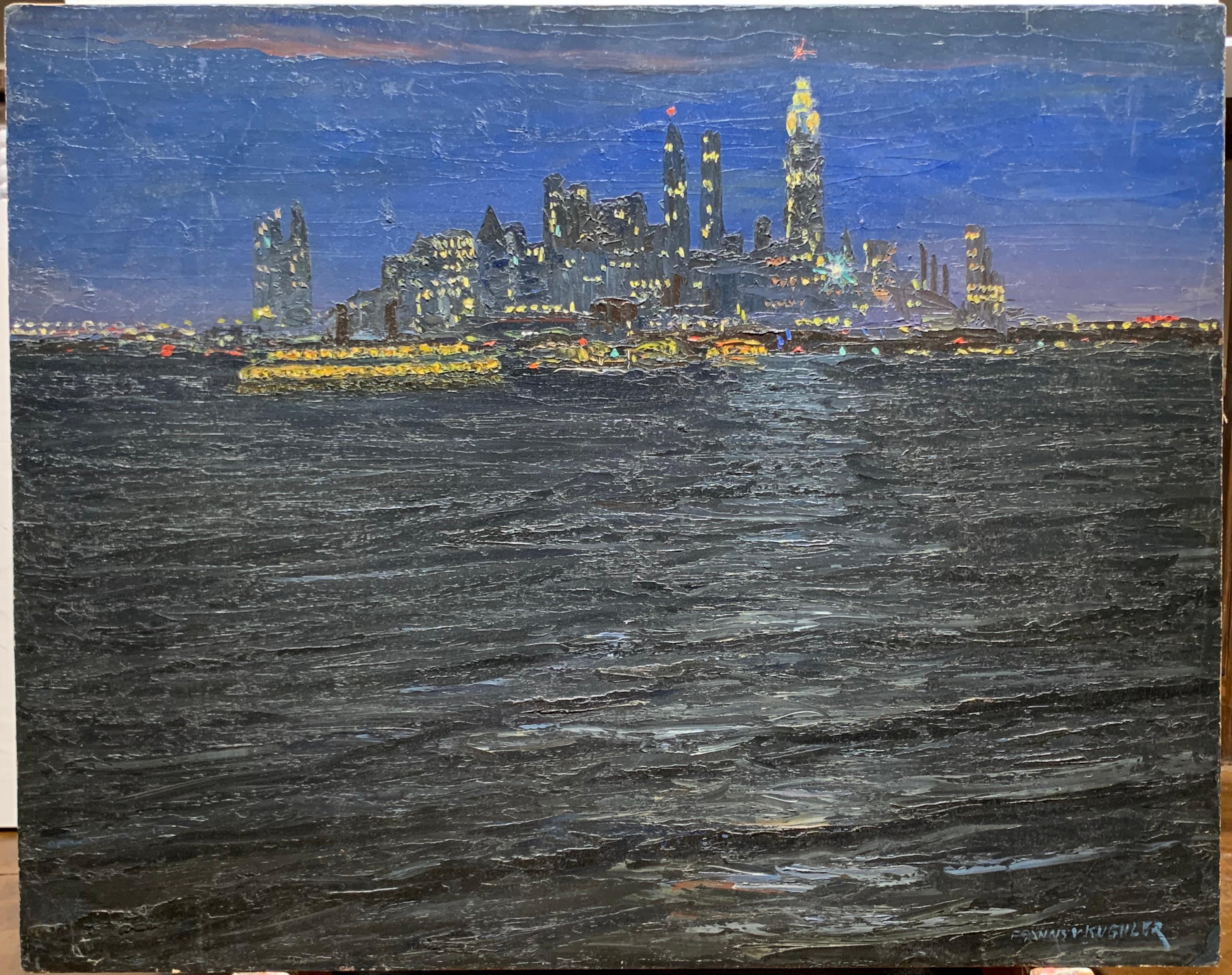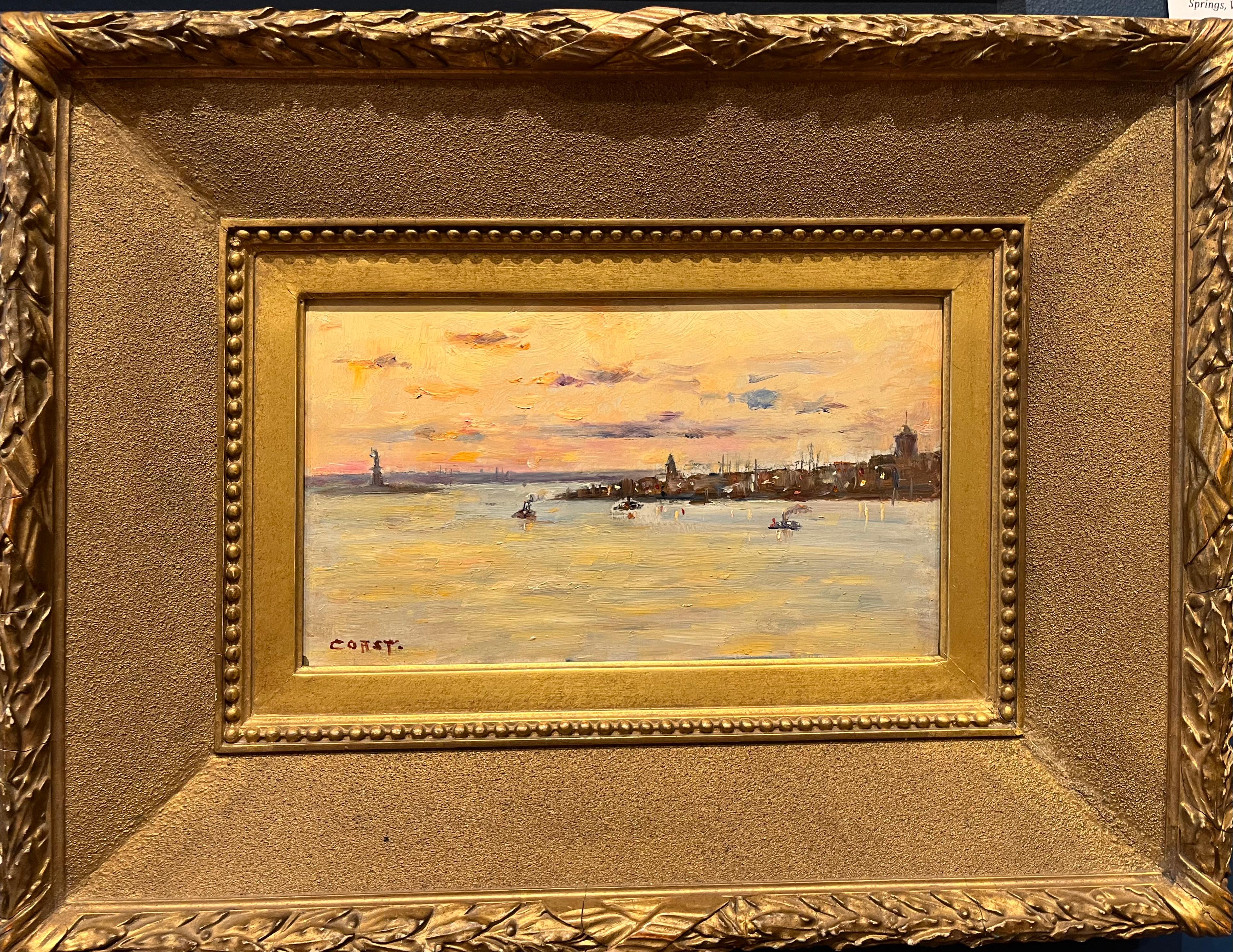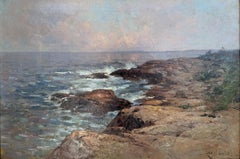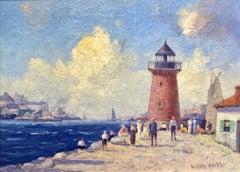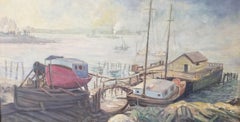Items Similar to "View of New York Harbor, Staten Island Ferry, " Gustave Wolff, Impressionism
Want more images or videos?
Request additional images or videos from the seller
1 of 8
Gustave Wolff"View of New York Harbor, Staten Island Ferry, " Gustave Wolff, Impressionism
$6,000
£4,534
€5,235.66
CA$8,384.09
A$9,302.86
CHF 4,873.04
MX$114,078.02
NOK 61,983.36
SEK 58,509.65
DKK 39,045.60
Shipping
Retrieving quote...The 1stDibs Promise:
Authenticity Guarantee,
Money-Back Guarantee,
24-Hour Cancellation
About the Item
Gustav (Gustave) Wolff (1863 - 1935)
View of New York Harbor from the Staten Island Ferry
Oil on canvas
16 x 12 inches
Signed lower right
In the Autumn of 1913, the German Association for Culture featured the work of Gustave Wolff (1863- 1935) in one of the artist's first New York City exhibitions held at the Yorkville Library. The New York Times stated, "Mr. Wolff is better known in the West and in Europe than in New York, and this is the first opportunity to see a collection of his work in this city."
A painter of Impressionist and Tonalist landscapes, Wolff arrived in New York most likely within the year prior to this exhibition. However, by the 1910's, the American art scene was witnessing a shift toward modernism. American Impressionism, which began as a rebellion against conservative academic artistic standards, was now endorsed by the National Academy of Design, while urban realism and abstraction became the new form of artistic protest. Having matured artistically around the turn of the century, just before this major shift, Gustave Wolff remained committed throughout his career to capturing the everyday poetry of the rural and urban landscape.
Raised in St. Louis after his family immigrated to the United States in 1866 from Berlin, Germany, Wolff studied at the St. Louis School of Fine Arts and with Paul Cornoyer, F. Humphrey Woolrych, and Frederick Oakes Sylvester. By 1901, Wolff had become the preeminent painter in St. Louis and a frequent exhibitor with the St. Louis Artists' Guild, the Society of Western Artists, and the Two-By-Four Club, leading one critic to write:
"If the maxim that artists are born, not made, be true, it applies most decidedly to Mr. Wolf [sic], whose training was as unsystematic and interrupted as his career was subjected to influences most unfavorable to his artistic development. But in spite of all difficulties he has forged his way to the front until his work has become of such importance that an exhibit of Western Artists would be incomplete without his admirable landscapes."
By 1906, Wolff was considered one of the leading landscape painters in St. Louis. It was in that year that two of his paintings were accepted to the Paris Salon. One humorous and rather cynical article discussed Wolff's success:
"Gustav[sic]Wolff of St.Louis,who does the fine art decoration of the billboards behind which you threw the tin cans this spring, has just had a bit of luck . . . [T]he people who sniffed when they saw Mr. Wolff sitting under a screen and daubing the billboards are surprised to learn that two pictures of his have now been accepted by and are hung conspicuously in the Paris salon. He is known in Paris as a landscape painter of ability and exquisite workmanship."
Like many American painters in this period, Wolff traveled to the Netherlands for further artistic training. In the late nineteenth century, there was a growing fascination in the United States with Dutch Art of the seventeenth-century, which became widely collected. At the same time, more affordable works by contemporary Dutch artists working in The Hague were increasingly collected especially by patrons in St. Louis.
Guided by Dutch Old Master depictions and romanticized literary descriptions, American artists visiting the Netherlands produced images of domesticity, strong communities, and religious values. Having trained in St. Louis, where Dutch artistic influence was strong, Wolff had already adopted the loose, confident brush- work and atmospheric effects that characterize Dutch painting.
When Wolff arrived in New York City in the early 1910s, he would have encountered the group of urban realist painters who dominated the New York art scene. The Eight, or the artists of the Ashcan School, were known for their frank, un-idealized depictions of common people and the industrial energy of New York. Their works presented the appealing, yet gritty reality of this urban environment and the transitory nature of the city. Wolff's paintings of everyday life often depict scenes of leisure, typical of the Impressionist manner. However, expressing the character of the modern metropolis was also a significant statement of his work.
Wolff's light-filled images such as Washington Heights Bridge, New York; and Approaching the Wheelock Mansion, West 160th Street, New York express the joy of leisure and relaxation that was sought amid the density and grittiness of New York. Like the paintings of American Impressionist William Merritt Chase, who had spent the early 1870's active in the St. Louis art scene, and who was considered one of the most important artists and teachers in New York by the turn of the century, Wolff's scenes of urban leisure are populated by New York's fashionable elite.
Approaching the Wheelock Mansion, West 160th Street, New York depicts well dressed New Yorkers walking along a path that cuts neatly through a field, the lushness of which is enhanced by Wolff's loose and rapid application of vibrant tones of green. Wheelock Mansion was built in the 1860's in Audubon Park by William A. Wheelock and remained an important monument to Victorian style architecture amid the rapidly changing city until its demolition in 1939. Wolff's meditation on this fleeting moment of urban life and the anonymity of the figures on the path can easily be compared to the Ashcan artists' illustration of interactions between strangers in New York's public spaces.
In contrast to his scenes of leisure, Wolff also produced paintings of New York's commercial activity. Typical of the Impressionist mode, A Winter Day, 79th Street Boat Basin, New York displays Wolff's mastery of color and light effects in the lavender and orange clouds juxtaposed against the crisp blue sky, and the rippled shadows of the boats on the water.
Wolff's confidence and control is revealed in the sweeping brush- strokes of the water and the rough texture of the sky, demonstrating the influence of artists like Chase and John Singer Sargent. His grittier scenes reveal the industrial activity along the shores of New York. In Harlem River Factories, New York, Wolff balances the flourish of Impressionist brushstrokes in the bright white clouds with the browns and grays of the murky water. The artist has noticeably omitted any figures from this image, instead focusing on the stark beauty of this commercial waterfront. A decade after his arrival in New York, Wolff continued to exhibit his river and harbor scenes to favorable reception from the press.
- Creator:Gustave Wolff (1863 - 1935, American)
- Dimensions:Height: 22 in (55.88 cm)Width: 18 in (45.72 cm)
- Medium:
- Movement & Style:
- Period:
- Condition:
- Gallery Location:New York, NY
- Reference Number:1stDibs: LU1841210505942
About the Seller
5.0
Platinum Seller
Premium sellers with a 4.7+ rating and 24-hour response times
Established in 2022
1stDibs seller since 2022
109 sales on 1stDibs
Typical response time: <1 hour
- ShippingRetrieving quote...Shipping from: New York, NY
- Return Policy
Authenticity Guarantee
In the unlikely event there’s an issue with an item’s authenticity, contact us within 1 year for a full refund. DetailsMoney-Back Guarantee
If your item is not as described, is damaged in transit, or does not arrive, contact us within 7 days for a full refund. Details24-Hour Cancellation
You have a 24-hour grace period in which to reconsider your purchase, with no questions asked.Vetted Professional Sellers
Our world-class sellers must adhere to strict standards for service and quality, maintaining the integrity of our listings.Price-Match Guarantee
If you find that a seller listed the same item for a lower price elsewhere, we’ll match it.Trusted Global Delivery
Our best-in-class carrier network provides specialized shipping options worldwide, including custom delivery.More From This Seller
View All"Gloucester Harbor" Laura Woodward, Cape Ann Marine Scene, Hudson River School
By Laura Woodward
Located in New York, NY
Laura Woodward
Gloucester Harbor, circa 1880
Signed lower left
Oil on canvas
18 x 24 inches
Provenance:
Private Collection, United Kingdom
Priory Fine ...
Category
1880s American Impressionist Figurative Paintings
Materials
Canvas, Oil
"Soir de Novembre, Dordrecht, " Eugene Vail, Dutch Landscape with Boats, Cloudy
By Eugène Lawrence Vail
Located in New York, NY
Eugène Laurent Vail (1857 - 1934)
Soir de Novembre, Dordrecht
Oil on canvas
19 1/4 x 25 3/4 inches
Signed lower left; titled in two places on the stretcher with various other inscriptions, stamped "MADAME G:VAIL A" and inscribed "177" in ink and "#43" in pencil on a partial label from Garde-Meuble Maple affixed to the stretcher
Eugene Vail (Saint-Servan, France September 29, 1857 - Paris, December 28, 1934), the son of a French mother and an American father, Lawrence Eugene Vail, studied at the Stevens Institute of Technology in Hoboken, New Jersey (where Alfred Stieglitz was born in 1864) and graduated with a degree in mechanical engineering in 1877. Then he became a student of William Merritt Chase and J. Carroll Beckwith at the Art Students League before returning to France. He entered the Ecole des Beaux-Arts in 1882 where he was instructed by Alexandre Cabanel, Raphaël Collin, and Dagnan-Bouveret (1852-1929), known as an extreme naturalist. When Bastien-Lepage died in 1884, Dagnan-Bouveret became the leader of the Naturalist School. He definitely made an indelible impression on Vail.
According to Louise Cann, Vail soon became an independent painter working at Pont-Aven and Concarneau. It is difficult to determine when he separated from his teachers since he is listed as a student whenever he exhibited at the Paris Salon — that is, until 1899 when he dropped the mention of élève. A picture of a peasant girl, Seulette was his Salon debut painting in 1883, the same year that he sent two scenes of Brittany to the Pennsylvania Academy of the Fine Arts' exhibition, which documents his stay in that region.
The next year he exhibited in the Salon: Fishing Port, Concarneau, which went to the Luxembourg Museum (it is now in the Musée Municipal of Brest). It has the Naturalist brown and gray palette and tonalist atmosphere but already shows that Vail had direct experience with scenes of life in coastal villages: "So convincing was his familiarity with the French coast that the critic Thiébault-Sisson claimed him as a Frenchman and declared that no American marine painter could touch his skill." (Maureen C. O'Brien, in Blaugrund, 1989, p. 218).
In 1885, Vail exhibited Inner Port at Dieppe and in the following year On the Thames (Private collection), which later won him the Grand Diploma of Honor from an international jury in Berlin in 1891. Widow, the title of Vail's entry in the Salon of 1887 (unlocated), is a striking image of a woman standing on a beach, looking out to the expanse of the ocean where her husband obviously met his end. The innocent child who looks at us may have the same fate in store for him. Then in 1888, Vail completed his masterpiece, Ready, About! a "wall-size" 94 x 125½ inch canvas. The painting won a first-class gold medal in the Salon of 1888, then at the Paris Universal Exposition of 1889, Vail won another gold medal.
The first precedent that comes to mind is Théodore Géricault's colossal Raft of the Medusa of 1819 (Louvre), the celebrated romantic image of castaways about to be rescued after being lost at sea. But while Géricault presents a massive, sculpturesque group of figures struggling on a raft just beyond our designated viewing space, Vail pulls the viewer into the picture, or more exactly, extends the diagonally rocking boat into the spectator's area, vividly anticipating the effects of cinematography. There is no more effective way to engage the spectator's attention and sympathies, and the illusionism is especially effective in this life-size picture.
Vail's vigorous brushwork — a uniform use of rectangular strokes — adds to the motion-filled, dynamic actuality of this image, and the overall green-gray tonalities evoke the constantly menacing, cold and wet travails in the life of the fishermen in the Atlantic's rough waters. Theodore Child (1889, p. 518) wrote about this painting: "very beautiful in color, and amongst the very strongest and best pictures of this kind in the Exhibition."
Dordrecht (unlocated) was Vail's painting exhibited at the Pennsylvania Academy in 1892, and in the following year he showed Fisherman — The North Sea at the Paris Salon, the same year in which he re-exhibited Dordrecht and On the Thames at the World's Columbian Exposition in Chicago. Vail won the coveted Légion d'Honneur in 1894. Some of his paintings found their way to European museums, for example, Soir de novembre (Odessa Museum) and Soir de Bretagne (Museo d'Arte Moderna, Venice). The latter was exhibited at the Exposition Universelle of 1900 in Paris. Also there was Voix de la mer (Voices of the Sea), which we identify as the painting that appears in an interior view of the American section, just to the right of a doorway (fig. 20 in Fischer, 1999), a simple marine painting.
Some time after 1900, Vail turned to both impressionism and post-impressionism but no one seems to have charted this course. His Autumn near Beauvais, illustrated in International Studio (1902, p. 211), The Flags, St. Mark's Venice (1903; National Gallery of Art), and Grand Canal, Venice, ca. 1904 (Museum of Art, Rhode Island School of Design) demonstrate an impressionist technique with broken color. Mandel (1977, p. 202) wrote on the latter: "applied in short strokes juxtaposing brilliant hues of orange, blue, white, black and red, with a strong interplay between the warm pink tones of the walls and the green shadows of the black boats which are silhouetted against them." Cann (1937) believed that in Venice, Vail "found his true self." The Flags forecasts the Armistice Day pictures by Hassam and others, painted fifteen years later.
Vail became involved in the Society of American Artists in Paris and the Société Internationale de Peinture et de Sculpture, whose membership included Frank Brangwyn, Charles Cottet (1863-1924), the famous Naturalist sculptor Constantin Meunier (1831-1905), Frits Thaulow...
Category
Early 20th Century American Impressionist Landscape Paintings
Materials
Canvas, Oil
"Shelter Island, Long Island" Julian Onderdonk New York Coastal Landscape
By Julian Onderdonk
Located in New York, NY
Julian Onderdonk
Shelter Island, Long Island, New York, circa 1905
Signed "Chas Turner" lower right
Oil on canvas
14 x 19 1/2 inches
Julian Onderdonk was...
Category
Late 19th Century American Impressionist Landscape Paintings
Materials
Canvas, Oil
"Coastal Scene" George Henry Smillie, Hudson River School, Rocky Coast, Cloudy
By George Henry Smillie
Located in New York, NY
George Henry Smillie
Coastal Scene
Signed lower right
Oil on canvas
20 x 30 inches
Provenance
Collection of Sylvia and Saverio Giammalva, Houston, Texas
The career of George Smill...
Category
1880s Hudson River School Figurative Paintings
Materials
Canvas, Oil
"Nantucket, Massachusetts" Helen Goodwin, American Impressionism Docks at Harbor
Located in New York, NY
Helen M. Goodwin (1865 - 1955)
Nantucket, Massachusetts
Oil on canvas laid on panel
12 x 16 inches
Signed and titled lower right
Helen M. Goodwin was born in New Castle, Indiana in ...
Category
Early 20th Century American Impressionist Landscape Paintings
Materials
Oil, Panel, Canvas
"West Point" John Ferguson Weir, Hudson River School Landscape with Sailboats
By John Ferguson Weir
Located in New York, NY
John Ferguson Weir
West Point, 1873
Signed and dated lower left
Oil on panel
12 1/8 x 20 1/8 inches
Provenance:
Sotheby's Arcade, American Paintings, December 19, 2003, Lot 1091
Spanierman Gallery, New York
Private Collection, New York (acquired directly from the above)
Exhibited:
Roslyn, Nassau County Museum of Fine Art, William Cullen Bryant, The Weirs and American Impressionism, April 24, 1983-July 31, 1983.
A painter, sculptor, writer, and teacher, John Weir was a highly talented man whose painting was overshadowed by his father, Robert Weir, the long-time West Point Academy drawing teacher, and his brother, J Alden Weir, well-known impressionist painter.
His distinguished reputation was primarily based on his accomplishments as a teacher and administrator. For many years, from 1869 to 1913, John Weir was the Director of the Yale University School of Fine Arts. He was also a commissioner of the art exhibition at the Centennial Exposition in Philadelphia.
Weir was born at West Point, New York, and by age 20, had a studio in New York City in the Tenth Street Studio Building, the first building in America dedicated to art studios, and there he associated with many leading painters of the day.
He earned attention early in his career for paintings of industrial scenes...
Category
1870s Hudson River School Landscape Paintings
Materials
Oil, Panel
You May Also Like
The Little Red Lighthouse, New York
By Gustave Wolff
Located in Missouri, MO
The Little Red Lighthouse, New York
By Gustave Wolff (1863-1935)
Signed Lower Right
Unframed: 14" x 19.25"
Framed: 20.25" x 25.25"
Painter Gustav Wolff ...
Category
Late 19th Century Land Landscape Paintings
Materials
Canvas, Oil
Price Upon Request
American Impressionist sketch of an American Yacht moored in a harbor , CT or MA
By Charles Bertie Hall
Located in Woodbury, CT
American Impressionist sketch of an American Yacht moored in a harbor ,CT or MA
Charles Bertie Hall painted scenes all over England, Europe, and America in a traditional Impressioni...
Category
2010s Impressionist Landscape Paintings
Materials
Oil, Board
New York Harbor
By Guy Wiggins
Located in Saratoga Springs, NY
Signed lower right.
Guy Carleton Wiggins adopted the bright palette and lively brushwork of the impressionist movement, and is best known for his New York City snow scenes...
Category
Mid-20th Century American Impressionist Landscape Paintings
Materials
Canvas, Oil
$85,000
"View From South Ferry" Landscape, Impressionism, Seascape
By Nelson H. White
Located in Sag Harbor, NY
"View from South Ferry" depicts the astonishing view from Sag Harbor's South Ferry that looks directly at Shelter Island.
Nelson H. White was born in New London, Connecticut in 1932. White has been surrounded by art and artists from the time he was born. He received his earliest art instruction from his grandfather, Henry Cooke White (1861-1952) and his father Nelson Cooke White (1900-1989), both important American artists. The family lived in Waterford, Connecticut and the elder White had been an early member of the art colony in Old Lyme, Connecticut. Known for his paintings of the Connecticut landscape and shoreline, Henry Cooke White became a teacher to his son, Nelson Cooke White. Living with his parents at the Florence Griswold house in Old Lyme, he met some of the most important and influential artists of the day, Childe Hassam, Will Howe Foote and Harry Hoffman.
Later, Nelson White's father began to take his family to summer on Shelter Island and became friendly with many of the artists of the Peconic colony such as Irving Wiles, an important American impressionist. After graduating from the Tabor Academy in Marion, Massachusetts in 1951, Nelson H. White began to study at Mitchell College in Connecticut but left to pursue studies in the violin, musical theory and composition. At this time, he began to spend more time studying art with his father and grandfather. By 1955, Nelson H. White had decided to devote himself to a career as a painter and traveled to Florence, Italy to become an apprentice to Pietro Annigoni, the world-renowned Florentine master. Within two years, the young White had won two awards for his work. While in Florence he also studied with the great Italian teacher, Nerina Simi. Today, White divides his time between the United States and Florence.
Although he has received instruction from some very important artists, White's work is highly individual. He paints with great spirit. Upon seeing his work one quickly senses White’s great love for nature and the outdoors. Through his eyes we are able to view and interpret nature in an intimate manner. Whether Nelson H. White is painting the Connecticut shore...
Category
21st Century and Contemporary American Impressionist Landscape Paintings
Materials
Oil
Lower Manhattan at Dusk from New York Harbor
By Francis Vandeveer Kughler
Located in Wilton Manors, FL
Francis Vendeveer Kughler (1901-1970. Manhattan Skyline from New York Harbor, ca. 1940. Oil on canvas mounted to masonite, 24 x 30 inches. Unframed. Excellent condition with no conservation. Signed lower right.
1901–1970
Born in New York City Kughler was educated in New York City public schools and art schools: De Witt Clinton High School, Cooper Union, the Mechanics' Institute and the National Academy of Design School of Art where he met Charlotte Livingston, an artist, whom he was later to marry. During this period he was the winner of a Tiffany scholarship, which provided him a summer of landscape painting at the Louis Comfort Tiffany estate at Oyster Bay, L.I.In the 1940s, Kughler became the President of the Salmagundi Club a well-known club in Washington Square in New York City that had been the singular gathering place for such great artists as Childe Hassam, William Merrit Chase...
Category
Mid-20th Century American Impressionist Landscape Paintings
Materials
Masonite, Oil
New York City Landscape Oil Painting with Statue of Liberty, New York Harbor, NY
Located in Fredericksburg, VA
Oscar Regan Coast was an American landscape painter. This artist was trained and studied in both Paris and Rome. After his studies, he moved back to the United States and spent a maj...
Category
Late 19th Century Impressionist Landscape Paintings
Materials
Oil, Board
More Ways To Browse
New York Harbor Painting
Ashcan New York
European Harbor Paintings
Antique Harbor Paintings
American Express Train
Ferry Painting
Holland Painting Of Boats
Netherlands Painting Early 20th Century
Antique Tin Can
Antique Tin Cans
Dutch Street Scene
Dutch Harbor Painting
Antique Oak Island
Oil Painting Of Lavender Fields
White Oak Island
Dutch Winter Scene Painting
Maxims Paris
Victorian Winter Landscape
